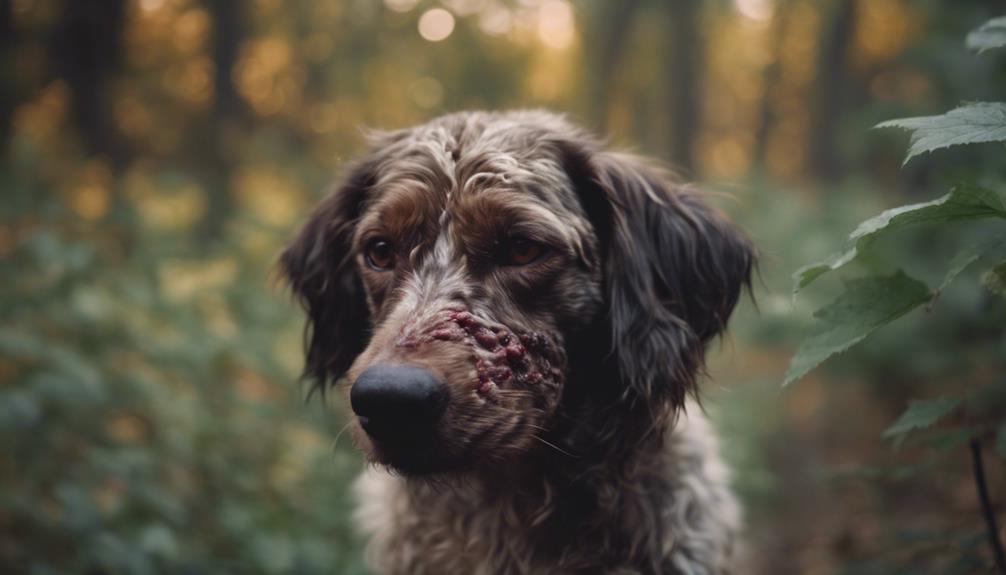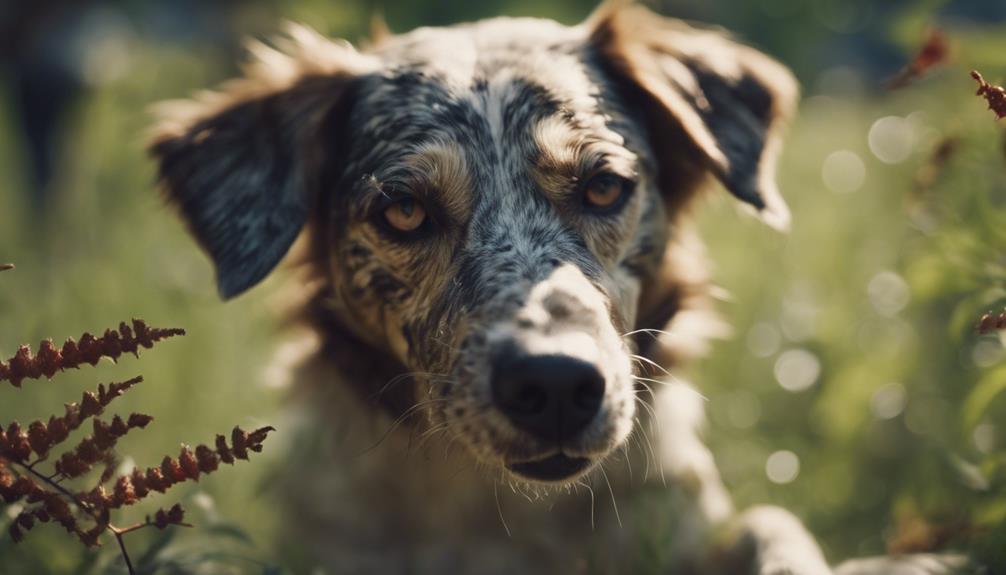Within the sphere of veterinary concerns, the query of whether dogs can be affected by Poison Ivy, Poison Oak, or Poison Sumac looms large. As pet owners strive to navigate the intricacies of plant toxicity, the potential risks to canine companions present a compelling avenue for exploration.
Understanding how these noxious plants interact with dogs, including the associated symptoms and treatment options, is paramount in safeguarding the health and well-being of our furry friends. The intricate interplay between nature and canine vulnerability beckons for closer examination to ensure proactive measures are in place to address any potential exposures effectively.
Key Takeaways
- Dogs can get affected by Poison Ivy, Poison Oak, or Poison Sumac through touch or ingestion.
- Urushiol, the plants' sap, causes allergic reactions in dogs.
- Symptoms in dogs include rash, itching, inflammation, and possible blisters.
- Immediate bathing with mild shampoo and seeking veterinary care for severe reactions is crucial.
Anacardiaceae Family of Plants
Belonging to the Anacardiaceae family of plants, Poison Ivy, Poison Oak, and Poison Sumac are well-known for their toxic effects on humans and animals. These plants contain urushiol, a potent oily sap that causes allergic reactions upon contact or ingestion.
Poison Ivy is identified by its green leaves in threes with jagged edges, while Poison Oak has rounded leaves in threes and white-yellow berries. Poison Sumac stands out with smooth-edged, elongated leaves in clusters of seven to 13. Found in woody or marshy areas, these plants pose a significant risk to dogs due to their fur offering limited protection against urushiol.
Understanding the characteristics of plants within the Anacardiaceae family is crucial for preventing toxic exposures in both humans and animals.
Identification of Poison Ivy
Poison Ivy can be recognized by its green leaves arranged in groups of three with jagged edges. These leaves can vary in size but typically have a pointed tip. The plant may also have small clusters of white berries.
When in contact with poison ivy, humans and dogs can develop an itchy rash due to the urushiol oil present in the plant's leaves, stems, and roots. It's important to note that poison ivy can grow as a vine or a shrub, and its appearance may change depending on the season.
Being able to identify poison ivy accurately is crucial for preventing exposure and adverse reactions in dogs and humans alike.
Identification of Poison Oak

In the Anacardiaceae family, Poison Oak is characterized by its rounded leaves grouped in threes and white-yellow berries. When identifying Poison Oak, it's essential to note the following features:
- Leaf Arrangement:
- The leaves are arranged in groups of three.
- The edges of the leaves are often rounded, unlike the jagged edges of Poison Ivy.
- The leaves may have a glossy appearance.
- Coloration:
- The leaves of Poison Oak can vary from green to reddish in color.
- The berries of Poison Oak are white-yellow and are a distinguishing feature.
- Growth Habit:
- Poison Oak typically grows as a shrub or a vine.
- It can be found in wooded areas, along trails, and in open fields.
- Avoidance of contact is key to preventing allergic reactions in both dogs and humans.
Identification of Poison Sumac
Identifying Poison Sumac involves recognizing distinct features that set it apart from other plants in the Anacardiaceae family. Poison sumac has smooth-edged, elongated leaves that grow in clusters of seven to thirteen. To aid in distinguishing Poison Sumac from Poison Ivy and Poison Oak, the following table outlines key characteristics of Poison Sumac:
| Features | Poison Sumac |
|---|---|
| Leaf Arrangement | Clusters of 7 to 13 smooth-edged leaves |
| Leaf Color | Green with smooth edges |
| Berry Color | White to grayish-white |
| Habitat | Swamps, bogs, and wetlands |
| Geographical Distribution | Eastern and Southern United States |
Transmission to Dogs

Veterinarians commonly encounter cases where dogs are exposed to toxic plants like poison ivy, poison oak, or poison sumac. When it comes to the transmission of these plants to dogs, several key points should be considered:
- Modes of Transmission:
- Dogs can get affected through direct contact with the plant or by ingesting parts of it.
- Urushiol, the potent oily sap in these plants, is the main culprit behind their toxicity.
- Areas with less hair, like the belly and footpads, are more susceptible to urushiol penetration.
Understanding how these plants can affect dogs is crucial for prompt identification and treatment to prevent further complications.
Effects on Dogs
When dogs come into contact with poison ivy, poison oak, or poison sumac, they may experience a range of effects due to the toxic urushiol sap present in these plants. The effects on dogs can include rash, red and itchy skin, inflammation, raised bumps, and the development of blisters in the affected area.
Dogs may exhibit behaviors such as scratching, chewing, or biting the affected area, indicating discomfort. Ingestion of these plants by dogs can lead to mild symptoms like vomiting or diarrhea. It is essential to recognize these effects promptly and seek appropriate treatment to alleviate the discomfort and prevent any potential complications that may arise from exposure to poison ivy, poison oak, or poison sumac.
Allergic Reactions in Dogs

Upon exposure to poison ivy, poison oak, or poison sumac, dogs can develop allergic reactions triggered by the urushiol sap present in these plants. Allergic reactions in dogs may manifest in various ways:
- Skin Irritation: Dogs may experience red, itchy skin, inflammation, and raised bumps as a result of contact with these plants.
- Blisters: In severe cases, blisters may form on the affected area, causing discomfort and potential complications.
- Behavioral Changes: Dogs may exhibit increased scratching, chewing, or biting of the affected area due to the discomfort caused by the allergic reaction.
It is essential to monitor your dog for any signs of allergic reactions and seek veterinary care if symptoms persist or worsen.
Symptoms in Dogs
Symptoms of exposure to poison ivy, poison oak, or poison sumac in dogs typically manifest as skin irritation and discomfort. Dogs may exhibit signs such as red, itchy skin, inflammation, and raised bumps. These symptoms are often accompanied by a rash in the affected area.
Additionally, dogs may engage in scratching, chewing, or biting the irritated skin. In more severe cases, blisters may develop at the site of contact with the toxic plants. It is essential to monitor the dog for any signs of discomfort or unusual behavior, as prompt action can help alleviate the symptoms and prevent further complications.
If you suspect your dog has come in contact with poison ivy, poison oak, or poison sumac, it is advisable to seek veterinary care for proper diagnosis and treatment.
Blisters and Skin Reactions

Skin reactions in dogs exposed to poison ivy, poison oak, or poison sumac can manifest as blisters and other forms of irritation. These reactions can cause discomfort and distress to your furry companion. When dealing with skin reactions in dogs due to exposure to these toxic plants, it's important to be aware of the following:
- Blisters: Blisters may develop in the affected area, indicating a more severe reaction to the plant's oils.
- Red, Itchy Skin: Dogs may experience red, itchy skin as a result of the allergic reaction triggered by urushiol.
- Inflammation and Raised Bumps: In addition to blisters, inflammation and raised bumps may also appear on the dog's skin, further exacerbating their discomfort.
Ingestion Effects
Could the ingestion of poison ivy, poison oak, or poison sumac lead to severe health consequences for dogs? When dogs ingest these plants, they are at risk of experiencing adverse effects.
Ingesting poison ivy, poison oak, or poison sumac can result in mild symptoms such as vomiting or diarrhea in dogs. However, more severe consequences may occur if a larger amount of the plant is consumed. In such cases, dogs could develop gastrointestinal issues like stomach pain, excessive drooling, or difficulty swallowing.
Additionally, ingesting these toxic plants may lead to more serious outcomes such as respiratory distress or even neurological symptoms. Therefore, it is crucial to monitor dogs closely if they have ingested any part of poison ivy, poison oak, or poison sumac.
Immediate Bathing Protocol

In cases where dogs have come into contact with poison ivy, poison oak, or poison sumac, implementing an immediate bathing protocol is vital to minimize the risk of adverse reactions and alleviate potential discomfort for the animals.
Follow these steps for an effective immediate bathing protocol:
- Use lukewarm water: Lukewarm water helps open the pores and aids in removing the oil from the skin.
- Use a specialized pet shampoo: Opt for a shampoo specifically formulated for pets to avoid any skin irritation.
- Thoroughly rinse the fur: Ensure all areas, especially those with less hair, are thoroughly rinsed to remove any traces of the irritant.
Use of Mild Shampoo
A suitable and gentle approach to cleansing dogs exposed to poison ivy, poison oak, or poison sumac involves utilizing a mild shampoo specifically designed for pets. When selecting a shampoo, opt for products that are free of harsh chemicals and fragrances to prevent further irritation to the dog's skin.
Mild shampoos help to effectively remove any traces of urushiol, the oily sap responsible for the plants' toxic effects, from the dog's fur. Thoroughly lather the shampoo onto the affected areas, ensuring complete coverage. Rinse the dog with lukewarm water after shampooing to eliminate any residue.
This process should be repeated if necessary to ensure the removal of all potential irritants from the dog's coat.
Itch Relief Methods

Utilizing soothing remedies can provide effective relief for dogs experiencing itchiness due to exposure to poison ivy, poison oak, or poison sumac. To help alleviate your dog's discomfort, consider the following itch relief methods:
- Oatmeal Bath: Bathing your dog in cool water mixed with colloidal oatmeal can help soothe irritated skin and reduce itching.
- Aloe Vera Gel: Applying a thin layer of aloe vera gel directly to the affected areas can offer cooling relief and promote healing.
- Cold Compress: Gently applying a cold compress to itchy areas can help numb the skin, reduce inflammation, and provide temporary relief from itching.
Minor Vs. Severe Reactions
When assessing reactions to exposure to poison ivy, poison oak, or poison sumac in dogs, it is crucial to differentiate between minor and severe manifestations.
Minor reactions typically present with symptoms such as rash, red and itchy skin, inflammation, raised bumps, and potential mild vomiting or diarrhea if ingested. These mild cases can often be managed at home with bathing using a mild shampoo, like Dawn dish detergent, to remove the urushiol oil.
In contrast, severe reactions may include oozing blisters, scabs, excessive biting or scratching, fever, or loss of appetite. Such severe signs could indicate anaphylactic shock, requiring immediate veterinary attention. Recognizing the severity of the reaction is vital in providing timely and appropriate care for affected dogs.
Veterinary Care for Dogs

The appropriate veterinary care is essential for dogs exposed to poison ivy, poison oak, or poison sumac to address any potential allergic reactions and ensure prompt treatment of severe symptoms.
Veterinary care for dogs exposed to these plants may involve:
- Identification of the Allergen:
- Conducting tests to confirm exposure to poison ivy, poison oak, or poison sumac.
- Determining the extent of the allergic reaction and potential complications.
- Assessing the severity of symptoms to tailor treatment accordingly.
- Treatment Plan Implementation:
- Administering antihistamines or steroids to alleviate itching and inflammation.
- Providing topical treatments to soothe the skin and promote healing.
- Monitoring the dog for any signs of worsening symptoms or secondary infections.
Conclusion
In conclusion, understanding the risks associated with Poison Ivy, Poison Oak, and Poison Sumac is crucial for canine health. By recognizing the distinct characteristics of these plants and implementing preventive measures, pet owners can protect their dogs from potential exposure.
In cases of contact, prompt identification and appropriate treatment are essential to alleviate symptoms and ensure the well-being of our beloved canine companions. Veterinary care may be necessary for severe reactions, highlighting the importance of proactive management strategies.




